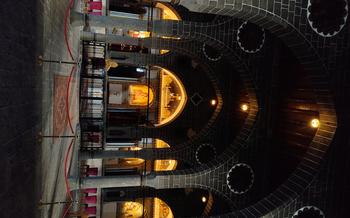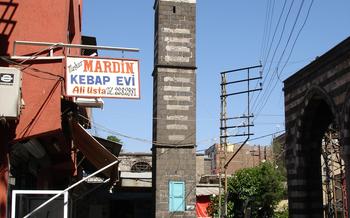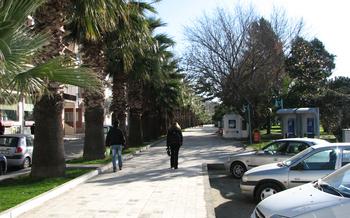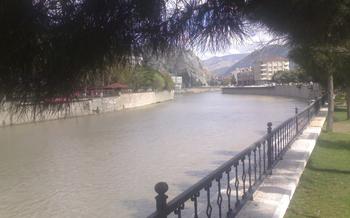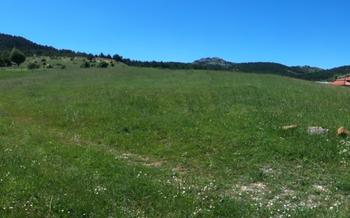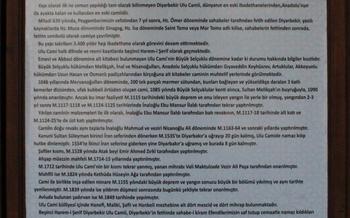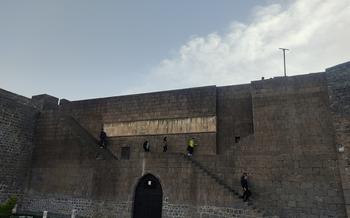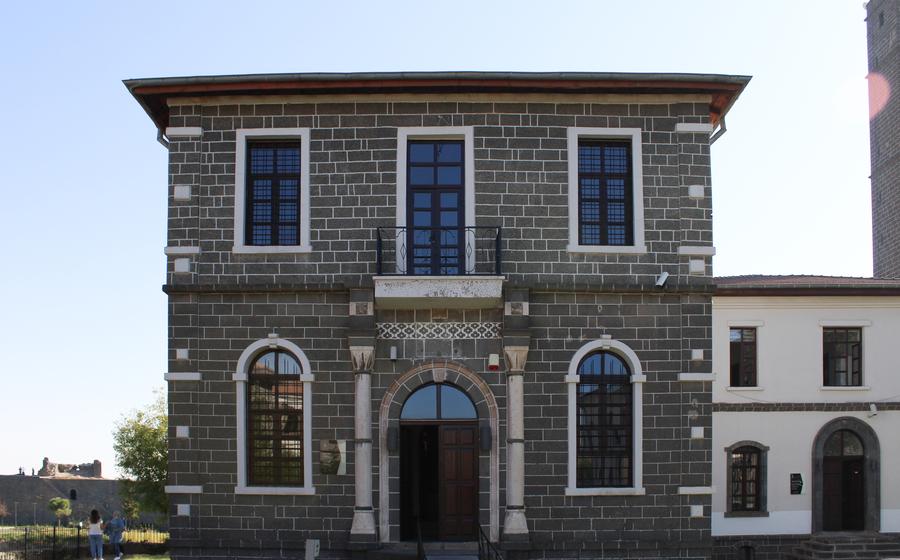
Diyarbakır Atatürk Museum
- Diyarbakır Atatürk Museum: A Journey Through History
- Exploring the Museum's Artifacts:
- The History of Diyarbakır
- The Museum's Building
- The Museum's Collections
- The Museum's Exhibits
- The Museum's Guided Tours
- The Museum's Accessibility:
- The Museum's Location
- The Museum's Hours and Admission
- The Museum's Events and Programs
- The Museum's Research and Publications:
- Insider Tip: Unveiling the Secrets of the Diyarbakır Atatürk Museum
Diyarbakır Atatürk Museum: A Journey Through History
The Diyarbakır Atatürk Museum, a treasure trove of history and culture, invites you on a journey through the storied past of Diyarbakır and the surrounding region. Enshrined within the walls of a majestic 19th-century building, the museum showcases an array of artifacts, relics, and exhibits that illuminate the rich tapestry of civilizations that have left their indelible mark on this ancient land.
Situated in the heart of Diyarbakır, the museum offers easy accessibility for visitors seeking to delve into the depths of this city's past. Immerse yourself in the grandeur of ancient civilizations, trace the footsteps of empires, and unravel the tales etched in stone and artifact. The Diyarbakır Atatürk Museum stands as a testament to the enduring spirit of this land, beckoning you to embark on an extraordinary journey through time.
Exploring the Museum's Artifacts:
The Diyarbakır Atatürk Museum houses a vast and diverse collection of artifacts that shed light on the rich history of the region. From ancient pottery and tools to intricate jewelry and sculptures, the museum's exhibits offer a glimpse into the lives and cultures of the various civilizations that have called Diyarbakır home.
One of the highlights of the museum's collection is the array of artifacts from the Neolithic period, including finely crafted pottery, stone tools, and figurines. These artifacts provide valuable insights into the early inhabitants of the region and their way of life.
The museum also boasts an impressive collection of artifacts from the Bronze Age, including bronze weapons, tools, and jewelry. These artifacts showcase the advanced metalworking skills of the region's ancient artisans and their mastery of metallurgy.
The museum's collection also includes artifacts from the Hellenistic, Roman, and Byzantine periods, reflecting the region's interaction with different cultures and empires. Visitors can admire exquisite mosaics, sculptures, and coins from these periods, each offering a unique perspective on the region's rich cultural heritage.
The Diyarbakır Atatürk Museum's collection is not only vast but also significant in terms of understanding the region's history. The artifacts on display provide tangible evidence of the diverse civilizations that have flourished in Diyarbakır, contributing to its unique cultural identity and rich historical legacy.
The History of Diyarbakır
Diyarbakır, a city in southeastern Turkey, boasts a rich and diverse history that spans several millennia. Its strategic location has made it a crossroads of civilizations, with various empires and cultures leaving their mark on the city.
Diyarbakır's origins can be traced back to the 10th century BC, when it was known as Amid. The city was conquered by the Assyrians in the 8th century BC and became part of their vast empire. Later, it fell under the rule of the Medes, Persians, and Greeks.
In the 4th century AD, Diyarbakır became part of the Byzantine Empire. The Byzantines built impressive fortifications around the city, which remain standing to this day. The city's strategic importance grew during the Byzantine period, as it became a key defensive outpost against invading armies from the east.
In the 7th century AD, Diyarbakır was conquered by the Arab armies of the Umayyad Caliphate. The city became an important center of Islamic culture and learning. The Umayyads built several mosques and madrasas (Islamic schools) in Diyarbakır, which contributed to its reputation as a center of scholarship.
During the Middle Ages, Diyarbakır was ruled by a succession of Muslim dynasties, including the Seljuks, the Artuqids, and the Ayyubids. Each of these dynasties left its mark on the city, contributing to its architectural, cultural, and religious heritage.
In the 16th century, Diyarbakır was incorporated into the Ottoman Empire. The Ottomans ruled the city for over four centuries, during which time it became a major administrative and military center. The Ottomans built several mosques, bridges, and caravanserais in Diyarbakır, which are still standing today and serve as testaments to their architectural prowess.
Diyarbakır's history is a testament to its resilience and its ability to adapt to changing circumstances. The city has been ruled by many different empires and cultures, but it has always maintained its unique identity. Today, Diyarbakır is a modern, vibrant city that is proud of its rich and diverse heritage.
The Museum's Building
The Diyarbakır Atatürk Museum is housed in a striking and historic building that reflects the city's rich architectural heritage. The building, originally known as the "Ziya Gökalp School," was constructed in the late 19th century during the Ottoman period. It served as an educational institution until the early 20th century, when it was converted into a museum.
The architectural style of the building showcases a blend of traditional Ottoman and modern elements. The exterior features intricate stonework, arched windows, and decorative turrets, while the interior boasts spacious rooms with high ceilings and polished marble floors.
Over the years, the building has undergone several renovations and restoration projects to maintain its structural integrity and historical charm. These efforts have ensured that the museum retains its original character while providing modern facilities for visitors.
Today, the Diyarbakır Atatürk Museum stands as a testament to the city's dedication to preserving its cultural heritage. The building's architectural beauty and historical significance make it an attraction in its own right, complementing the rich collection of artifacts housed within its walls.
The Museum's Collections
The Diyarbakır Atatürk Museum houses a diverse and comprehensive collection of artifacts that provide a glimpse into the region's rich history and cultural heritage. The collection includes a vast array of archaeological finds from excavations conducted in the Diyarbakır region, shedding light on the ancient civilizations that once thrived in the area. Among these artifacts are pottery, jewelry, tools, and weapons, each telling a story of the daily lives and customs of the region's past inhabitants.
The museum also boasts an impressive collection of ethnographic artifacts that showcase the local culture and traditions of Diyarbakır. These artifacts include traditional costumes, textiles, musical instruments, and household objects, providing visitors with an immersive experience of the region's vibrant heritage. The museum's collection of Islamic art and manuscripts is another highlight, featuring intricate calligraphy, illuminated manuscripts, and decorative objects that showcase the region's rich Islamic heritage.
The Museum's Exhibits
The Diyarbakır Atatürk Museum offers a diverse range of exhibits that showcase different aspects of the city's rich history and culture. Thematic exhibits delve into specific periods or themes, providing visitors with a comprehensive understanding of Diyarbakır's past. Interactive exhibits engage visitors with the museum's collection, allowing them to explore artifacts and learn about their significance in a hands-on manner. Temporary exhibits feature specific themes or artists, offering visitors a fresh perspective on the city's history and culture. The museum also organizes educational programs and workshops that provide visitors with a deeper understanding of Diyarbakır's heritage. These programs cover a variety of topics, including archaeology, history, and art, and are designed to engage visitors of all ages.
The Museum's Guided Tours
Diyarbakır Atatürk Museum offers guided tours in various languages, allowing visitors to delve deeper into the museum's collection and the history of Diyarbakır. These tours are led by knowledgeable and experienced guides who provide insights and information that enhance the museum experience.
The benefits of taking a guided tour are numerous. First, the tour guides offer a structured and informative narrative that helps visitors understand the significance and context of the museum's artifacts and exhibits. They provide historical background, explain the cultural and religious influences that shaped the region, and answer any questions visitors may have.
Second, guided tours allow visitors to access areas of the museum that may be restricted to the general public. This includes behind-the-scenes areas, storage facilities, and special exhibitions. Visitors can gain a glimpse into the museum's operations and learn about the research and conservation work that goes on behind the scenes.
Third, guided tours offer a more personalized and interactive experience. Visitors can engage with the tour guide, ask questions, and discuss various aspects of the museum's collection. This interaction creates a more memorable and enriching experience, allowing visitors to connect with the museum's history and culture on a deeper level.
To book a guided tour, visitors can contact the museum directly or through a tour operator. It is advisable to book in advance, especially during peak tourist seasons, to ensure availability. The museum offers a range of tour options, including group tours, private tours, and specialized tours tailored to specific interests or themes.
The Museum's Accessibility:
Diyarbakır Atatürk Museum is committed to providing an accessible and inclusive environment for all visitors, regardless of their abilities or disabilities. The museum features a range of facilities and services to ensure that everyone can enjoy and learn from its collection.
Wheelchair accessibility is a top priority at the museum. Ramps and elevators are available throughout the building, allowing visitors with mobility impairments to navigate the museum with ease. Accessible restrooms are also provided for the convenience of visitors.
For visitors with hearing or visual impairments, the museum offers audio guides and visual aids. These assistive devices provide detailed descriptions of the exhibits, making them accessible to visitors who may have difficulty seeing or hearing.
The museum staff is also trained to assist visitors with disabilities. They are available to provide information, guidance, and assistance to ensure that everyone has a positive and enjoyable experience at the Diyarbakır Atatürk Museum.
The Museum's Location
Diyarbakır Atatürk Museum is conveniently situated in the heart of Diyarbakır, a city renowned for its rich cultural heritage. Its central location makes it easily accessible to visitors, allowing them to seamlessly integrate a visit to the museum into their exploration of the city's other historical and cultural attractions.
The museum is situated within walking distance of Diyarbakır's historic city walls, providing an opportunity to delve deeper into the city's past. The iconic Great Mosque of Diyarbakır, with its awe-inspiring architecture, is just a short stroll away, inviting visitors to immerse themselves in the spiritual and cultural significance of this sacred site.
The museum's proximity to various transportation hubs further enhances its accessibility. The Diyarbakır Bus Terminal and the Diyarbakır Airport are both conveniently located, enabling visitors to easily reach the museum from different parts of the city and beyond.
Whether arriving by foot, public transportation, or taxi, visitors will find the Diyarbakır Atatürk Museum effortlessly accessible, allowing them to embark on a journey through history with ease.
The Museum's Hours and Admission
The Diyarbakır Atatürk Museum is open to the public from 8:00 AM to 5:00 PM, Tuesday through Sunday. It is closed on Mondays. Admission fees are quite reasonable, with adult tickets costing 10 Turkish Lira, children's tickets costing 5 Turkish Lira, and student tickets costing 8 Turkish Lira. The museum also offers free admission on certain days, such as International Museum Day and Children's Day. Visitors can take advantage of these opportunities to explore the museum's collection without any additional costs.
The Museum's Events and Programs
The Diyarbakır Atatürk Museum is not just a repository of artifacts; it's also a vibrant cultural hub that hosts a variety of events and programs throughout the year. These events are designed to engage visitors of all ages, foster a deeper understanding of Diyarbakır's history and culture, and promote the museum's mission of preserving and celebrating the region's heritage.
Special exhibitions are a highlight of the museum's calendar. These temporary exhibits showcase specific themes, artistic movements, or historical periods, often featuring artifacts from the museum's own collection as well as loans from other institutions. Past exhibitions have explored topics such as the history of Diyarbakır's fortifications, the art and culture of the region's nomadic tribes, and the influence of Islam on the city's development.
The museum also organizes workshops, lectures, and educational programs. These events provide opportunities for visitors to learn from experts in the fields of archaeology, history, and art. Workshops might focus on topics such as pottery-making, traditional weaving, or calligraphy, while lectures might explore the history of the region or the significance of specific artifacts in the museum's collection.
Educational programs are a key component of the museum's outreach efforts. The museum offers guided tours for school groups, tailored to different age levels and curriculum requirements. These tours bring history to life for students, allowing them to engage with the museum's artifacts and learn about the region's rich past.
Through its events and programs, the Diyarbakır Atatürk Museum strives to be more than just a museum; it aims to be a dynamic and engaging cultural center that fosters a sense of community and pride in the region's heritage.
The Museum's Research and Publications:
The Diyarbakır Atatürk Museum is not just a repository of artifacts; it is also a hub for research and documentation. The museum's dedicated team of scholars and researchers continuously engages in research projects to deepen the understanding of Diyarbakır's rich history and culture. The museum's publications, including books, journals, and catalogs, serve as valuable resources for researchers, students, and enthusiasts alike. These publications document the museum's collection, present the latest research findings, and contribute to the broader body of knowledge on Diyarbakır's history and archaeology.
The museum collaborates closely with scholars and researchers from various institutions, both in Turkey and abroad. This collaboration fosters the exchange of knowledge and expertise, leading to new insights and discoveries. The museum's research and publications play a vital role in preserving and disseminating knowledge about Diyarbakır's past, ensuring that it continues to inspire and inform future generations.
Insider Tip: Unveiling the Secrets of the Diyarbakır Atatürk Museum
To make the most of your visit to the Diyarbakır Atatürk Museum, consider exploring it during the off-season or on weekdays to avoid the crowds. This will give you ample time and space to delve into the museum's exhibits without feeling rushed.
As you wander through the museum's galleries, keep an eye out for hidden gems that often go unnoticed by visitors. These hidden treasures might include a captivating sculpture tucked away in a corner, an intricate mosaic concealed behind a doorway, or a rare artifact displayed in a less prominent section. Take your time to discover these hidden wonders and appreciate the museum's collection in its entirety.
After immersing yourself in history and culture at the museum, enhance your experience by savoring a delicious meal at one of the local restaurants or cafes near the museum. These eateries offer a delightful culinary journey, allowing you to sample the flavors and aromas of Diyarbakır's rich cuisine.
To complement your visit to the Diyarbakır Atatürk Museum, consider exploring other attractions in the city that offer a deeper insight into its history and culture. The iconic Diyarbakır Fortress, with its imposing walls and towers, is a must-see for history buffs. The Great Mosque of Diyarbakır, with its stunning architecture and intricate tilework, is another architectural masterpiece not to be missed. These landmarks, along with the vibrant local markets and bustling bazaars, will provide you with a comprehensive and unforgettable experience of Diyarbakır.
